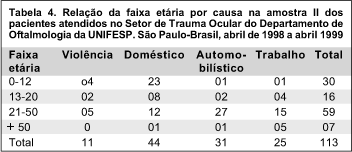Purpose: To study the epidemiologic profile of the patients with penetrating ocular trauma (POT) before and after the application of the new traffic code. Methods: Retrospective study of 253 patients with POT examined at the Ocular Trauma Section (UNIFESP) from January 1997 to April 1999. The patients were divided into 2 groups: Group I, patients with ocular trauma before the new traffic code; Group II, trauma history after the new code. The patients were evaluated regarding different aspects on trauma and ophthalmic evaluation. Results: The epidemiological findings regarding age, sex and race were similar in both groups. In group I, the patients between 21-50 years presented similar trauma etiology distribution, while in group II, in the same age range, they presented predominance of automotive-related trauma. Regarding seat belt use, 60% and 92% of patients were not using seat belts at the time of the trauma in groups I and II, respectively. 60% of the patients in group II mentioned alcohol consumption against 40% in group I. Conclusion: Besides the impact measures taken by state to control accidents, ocular trauma damages continue to be related to preventable risk factors like seat belt use and alcohol consumption.
Eye injuries; Traffic accidents; Seat belts; Retrospective studies







